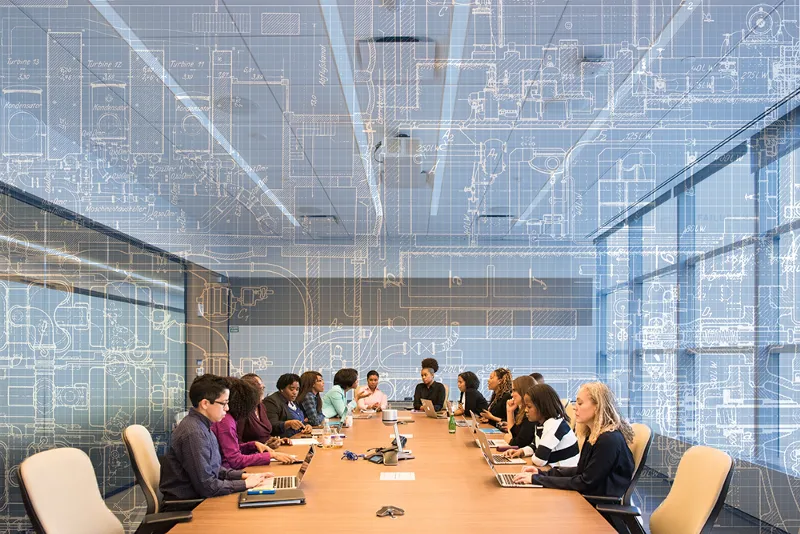
Digital Twins for Autonomous Buildings

What are Digital Twins?
A digital twin is a virtual version of a physical object, system, or process — the link between the physical and digital worlds. The concept was originally created by NASA when attempting to answer the question,
How do you operate, maintain, and repair a system when you can’t access it physically?
These digital representations of the physical world can be manipulated, simulated, and analyzed to help us understand systems, behaviors, and interactions of real-world objects that are too difficult or expensive to observe in the physical world. These digital models can be extended to predict the future, showing us the implications of a control or environmental change on the systems we are modeling.
By combining artificial intelligence (AI) and machine learning (ML) with digital twins, we can further extend their usefulness in predicting outcomes. An AI/ML engine can learn from the digital twin model to become more accurate. By applying economic analysis to our AI/ML engine, we can compare and optimize possible future outcomes based on variables in our digital twin simulations. For example, we can figure out which possible control scenario gives us the most energy efficient results.
We can extend the utility of our AI/ML digital twin engine even further by incorporating real-time real-world data and comparing it to our digital twin data. We can update our digital twins to make them more accurate and useful representations of the physical world.
In other words, we can use live sensor data to make the digital twin of a building more accurately reflect the buildings behavior (as measured). This improves our predictions and allows us to better optimize our controls.
The concept of digital twins has existed for decades. Unfortunately, their application has been limited by computational demand (real-time controls decisions couldn’t be calculated quickly enough) and high cost of deployment (expensive processors). The technology has advanced resulting in a decrease in the price per unit of computation ($/FLOP), and an increase in the reliability and resilience of self-defined networks. These changes mean that digital twins can be used in applications not previously considered due to cost or computation limitations.
If fact, we are now seeing digital twins being used in many industries. Gartner named digital twins as one of their Top 10 Strategic Tech Trends for 2017 and added DTO (Digital Twin of an Organization) to their Top 10 for 2019. In particular, as Internet of Things (IoT) technologies proliferate, digital twins are cropping up in our cars, appliances, building equipment, and so on.
Where Can You See Digital Twins in Use Today?
With digital copies of a hospital, its patients, staff, supplies, schedules, equipment, and building conditions, hospitals are able to monitor patients much more accurately and efficiently. In ThoughtWire’s EarlyWarning system, digital twins can predict and prevent code blue emergencies. In their pilot study, the EarlyWarning system reduced the number of code blues by 61%, not only creating a more comfortable experience for the patients, but also saving lives.
Chevron uses digital twins in a predictive maintenance initiative. They will “enable thousands of pieces of equipment with sensors by 2024 to predict exactly when equipment will need to be serviced.” They expect to save millions by monitoring and preventing most if not all equipment failures
At the Spring Festival Gala aired by China Central Television (CCTV) February 5, 2019, celebrity hosts were “twinned” with digital copies. The digital twins of the hosts were more than just computer-generated avatars; they were entirely created by AI. Their speech patterns, movements, and personalities were all incorporated into their “personal artificial intelligences” by ObEN, Inc.
Gartner reports that over 50% of large manufacturers plan to have at least one digital twin initiative by 2020, and by 2022 these numbers are expected to triple. These initiatives will be seen in operations and sales, modeling manufacturing, supply chain, fulfillment, channel relationships, business models, and nearly every other area of the industry.
Digital Twins & Autonomous Buildings
PassiveLogic employs digital twins at the core of its autonomous buildings platform. Autonomous buildings are more than just automated or monitored buildings. These buildings rely on digital twins to perform functions previously considered impossible with other technologies.
These functions include, but are not limited to:
- Simulating building operation
- Making control decisions independently
- Cooperating with other buildings in smart cities
- Predicting the future
- Evaluating the cost implications of control paths
- Responding to a full human comfort model
Digital twins, in fact, underpin PassiveLogic’s systems-based integrated intelligence approach to building management.
- With edge computing and digital twins, we can bring together systems whose controls were artificially independent.
- We can model occupant comfort using a more complete proxy than just the thermostat reading near their office. Thus, digital twins enable truly human-centered adaptive and responsive environments.
- Building managers can view introspective analysis about their building’s operation, giving them insight into not only what is going on, but also why and what to do about it.
- Using AI/ML to analyze real-time physical data with digital twin simulations, PassiveLogic can make informed decisions about the future rather than reacting to the past like all other building control systems.
- These digital twins can not only be used to predict the future, but for autonomous predictive maintenance, enabling the controls platform to prevent, route around, and repair problems before they even occur.
Digital twins open an entire range of opportunities in every industry and sector of the economy. Innovators are creating new applications for this core technology every day. Forward-looking business leaders are planning for how digital twins fit in their future strategies. PassiveLogic is leading the charge in the autonomous buildings sector.
PassiveLogic is developing the the first fully autonomous platform for buildings, built on digital twins from the ground up.